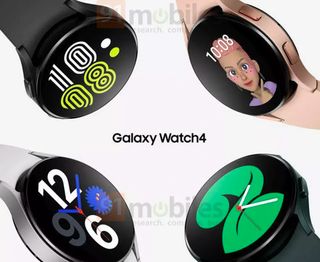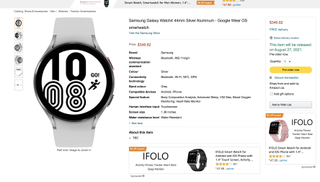Samsung Galaxy Watch 4 — body composition rumors raise concerns
Samsung Galaxy Watch 4 body composition analysis could be a game-changer, or a trouble-maker

The Samsung Galaxy Watch 4 could pack a health sensor capable of changing how we understand our bodies, if a premature Amazon listing for Samsung’s upcoming smartwatch included accurate specs.
Under the “special feature” section in the since-deleted Galaxy Watch 4 online product page, we see several familiar perks like sleep tracking, blood oxygen (SpO2) reading and heart rate monitoring. But this smartwatch, which could cost around $275 if the listed price translates precisely, also boasts “body composition analysis.” Such a feature has been rumored in recent weeks.
- Apple Watch 7 vs. Samsung Galaxy Watch 4: Which smartwatch will win?
- Best cheap smartwatches right now
- Plus: New Wear OS eligibility confirmed — can your smartwatch upgrade?

Samsung is likely waiting until an imminent Unpacked event, confirmed to be taking place on August 11, to reveal how body composition analysis on the Galaxy Watch 4 works. But since the Amazon listing apparently confirmed it’s coming, we can take some guesses as to the health data it’ll provide. We also can begin to address potential concerns that come with it.
Samsung Galaxy Watch 4: How could body composition analysis work?
Bioelectric impedance analysis (BIA) uses a weak electric current to determine body composition. On the best smart scales, body composition data can include body fat percentage, body mass index (BMI), muscle mass, bone mass, body water percentage and more.
According to a Scientific Reports journal published earlier this year, scale-based and wrist-based BIA readings differ in that the former is preferred for estimating subcutaneous (under-skin) fat, while the later can better estimate visceral and abdominal fat.
For wrist-based body composition analysis to work, the smartwatch would require "some type of bioimpedance analysis system," said Dr. Steven Heymsfield, Professor and Director of the Body Composition-Metabolism Laboratory at the Pennington Biomedical Research Center.
"Prototypes such as these appeared many years ago in various forms," said Dr. Heymsfield, confirming such a tool is possible for a smartwatch.
Sign up to get the BEST of Tom’s Guide direct to your inbox.
Upgrade your life with a daily dose of the biggest tech news, lifestyle hacks and our curated analysis. Be the first to know about cutting-edge gadgets and the hottest deals.
The Scientific Reports journal also highlights how wrist-wearable BIA sensors pose an accuracy problem: the smaller the BIA sensor, “the larger the impedance measurement error.” The researchers found that the electrodes needed to determine things like body fat percent “can be adapted into small devices,” though.
Samsung even earned a patent for just this kind of adaptation. Patently Apple pointed it out back in 2019, uncovering a “Wrist Wearable Body Composition Device” that requires one or two fingers pressed against sensors.
In the diagrams, it seems the sensors exist on or beneath the device’s strap. Since we expect the Galaxy Watch 4’s bands to be interchangeable, we’d guess Samsung adjusted its approach. It’s most likely the sensor is built into the base of the actual watch, though users might need to hold a finger to the side of the chassis or against a crown button for a scan to initiate.
Still, Dr. Heymsfield said, "one would need to check the accuracy against a reference method."
Samsung Galaxy Watch 4: Potential body composition concerns
Dr. Heymsfield points out why people responsibly managing their weight would want to understand their changing body composition.
"How much is fat and how much muscle?," said Dr. Heymsfield. "People are interested in these kinds of questions."
But, again, accuracy is a concern. And not just for the sake of the Galaxy Watch 4’s credibility and those monitoring their health goals — in my Amazon Halo review, I voiced hesitations about how unbridled access to body fat percent readings can perpetuate body dysmorphia and body disorder, especially when you can see what you might look like with a higher or lower reading.
Even without visualizations, an incorrect reading could similarly distort your understanding of your body. According to the Anxiety and Depression Association of America, approximately 1 in 50 people in the United States are affected by body dysmorphia, while ANAD reports that at least 9% of people worldwide are affected by eating disorders.
That's a considerable population of people who could be disservice with a body composition-reading smartwatch, if not directed properly.
Though at-home body fat readings are an exceptional health-tech feat, disclaimers are beyond necessary. Luckily only users 18 or older can use the Halo band's body scan feature. I wouldn’t be surprised if Samsung follows its lead and imposes an age requirement for the body composition analysis.
Samsung Galaxy Watch 4: Body composition analysis outlook
Despite a healthy dose of cynicism, the addition of body composition analysis could transform an already-popular smartwatch into an indispensable health tool. The Apple Watch 7 doesn't seem destined for a new wellness sensor, giving the Galaxy Watch 4 a leg-up against the reigning best smartwatch.
All eyes will be on Samsung when it the unveils what's shaping up to be a Samsung Galaxy Watch Active 2 follow-up. Let's just hope the company is prepared to address body composition analysis concerns — and demonstrate how the feature will be implemented responsibly.
- Samsung Galaxy Watch 4 vs. Samsung Galaxy Watch 3: Buy now or wait?
Kate Kozuch is the managing editor of social and video at Tom’s Guide. She covers smartwatches, TVs and audio devices, too. Kate appears on Fox News to talk tech trends and runs the Tom's Guide TikTok account, which you should be following. When she’s not filming tech videos, you can find her taking up a new sport, mastering the NYT Crossword or channeling her inner celebrity chef.

